Technical Manual
• Thank you very much for reading the preview of the manual.
• You can download the complete manual from: www.heydownloads.com by clicking the link below
• Please note: If there is no response to CLICKING the link, please download this PDF first and then click on it.

DRESSER M-4
BLAST HOLE DRILL MAINTENANCE AND OPERATION


This manual is divided into major sections covering various serviceable components and systems of the Rotary Blast Hole Drill. These sections and their contents are organized by thumb index tabs shown below and right - blue ink tab marks. To use this manual, grasp the right hand side of the book between thumb and fingers. Bend pages back to find the start of the corresponding sections in this index tab.
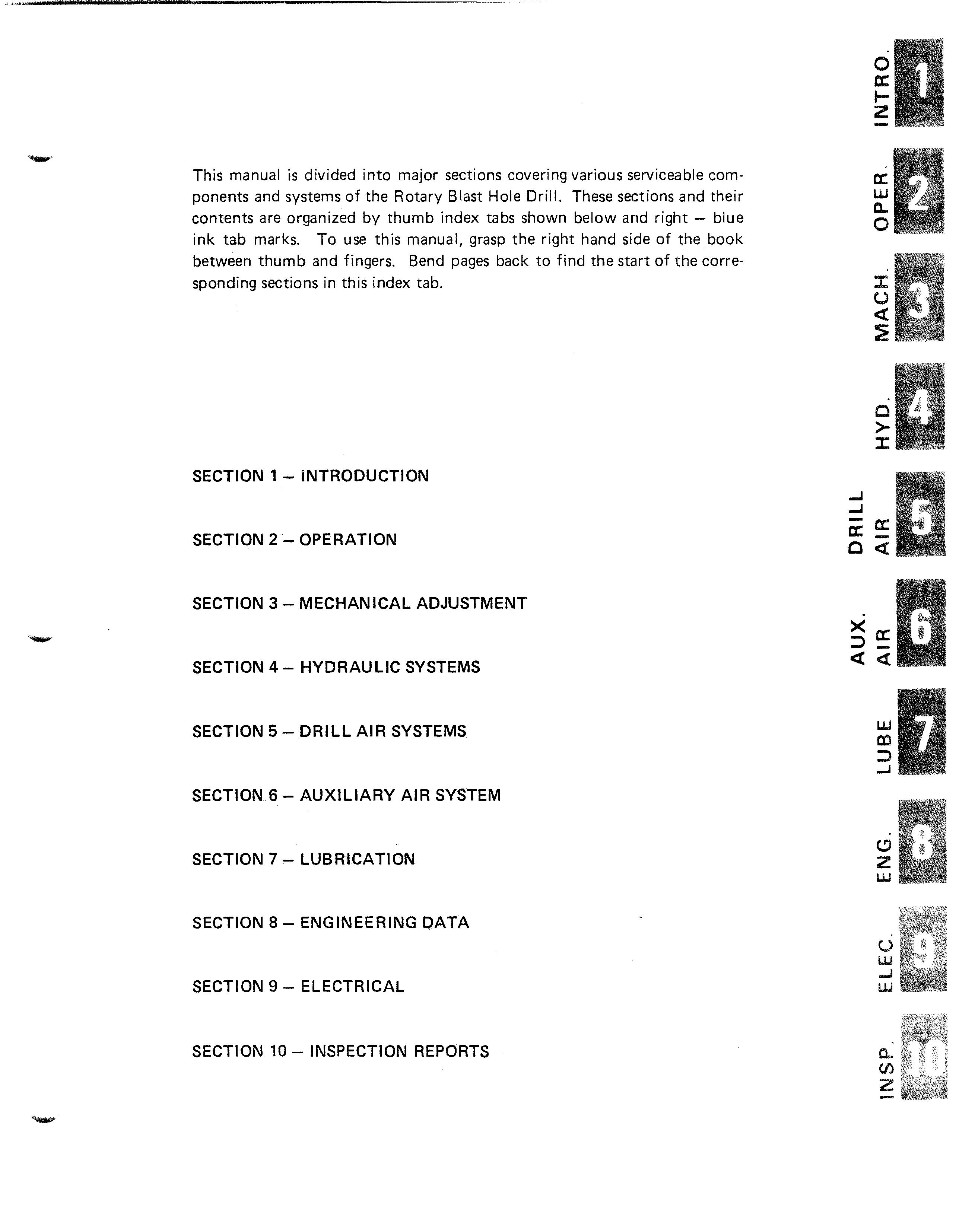
SECTION 1- INTRODUCTION
SECTION 2- OPERATION
SECTION 3- MECHANICAL ADJUSTMENT
SECTION 4- HYDRAULIC SYSTEMS
SECTION 5 - DRILL AIR SYSTEMS
SECTION.6 - AUXILIARY AIR SYSTEM
SECTION 7- LUBRICATION
SECTION 8- ENGINEERING QATA
SECTION 9- ELECTRICAL
SECTION 10 - INSPECTION REPORTS

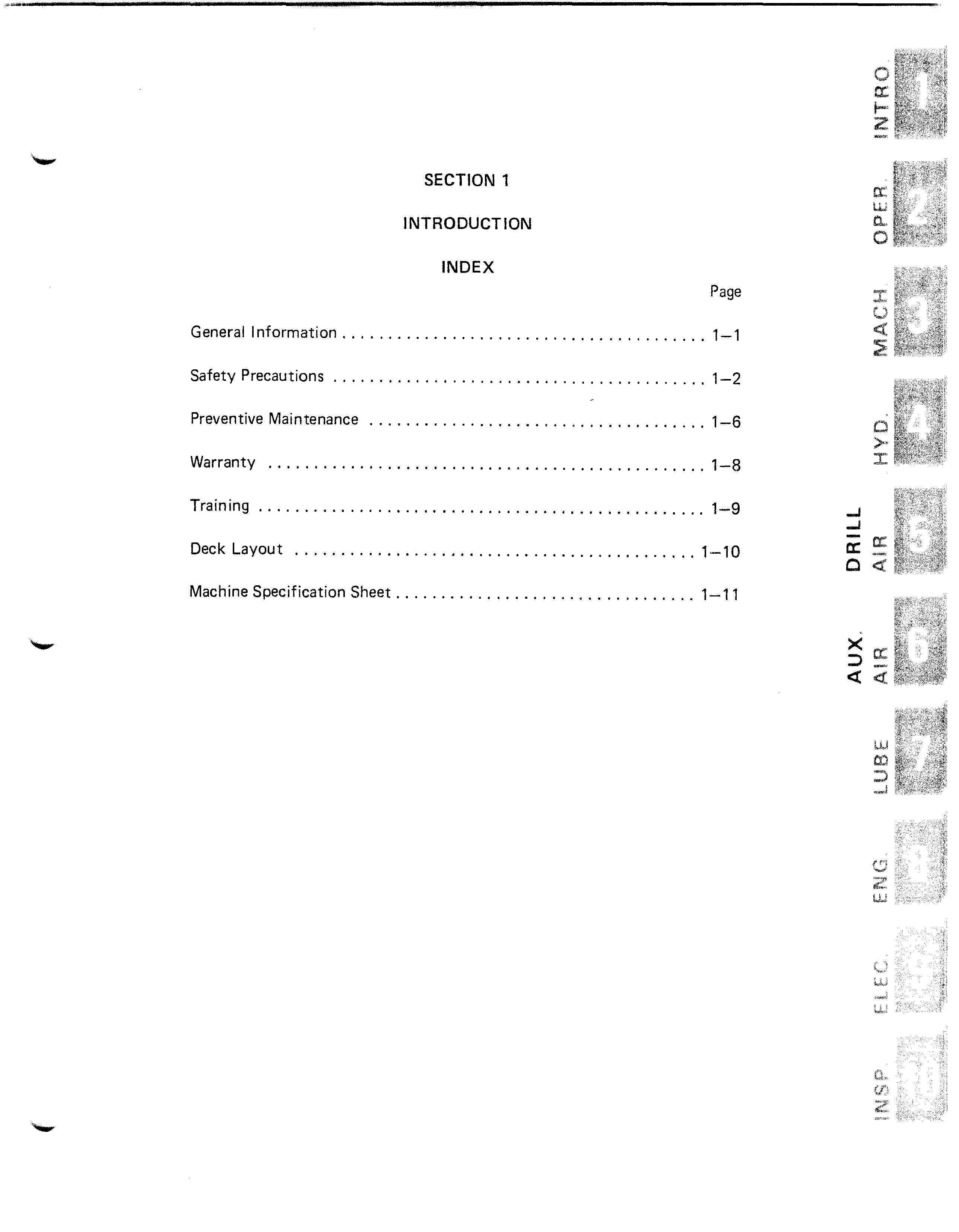
SAFETY PRECAUTIONS - continued
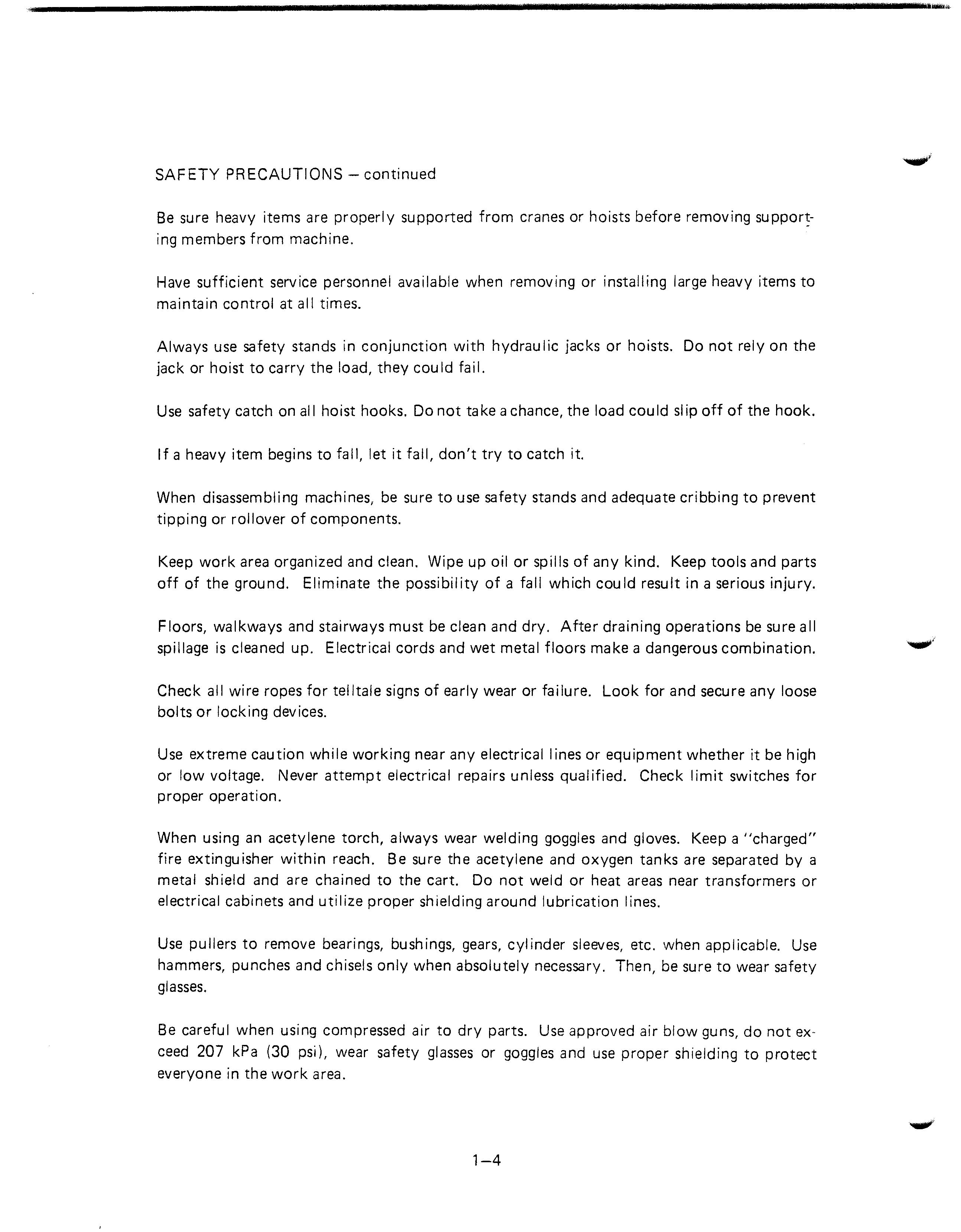
Be sure heavy items are properly supported from cranes or hoists before removing ing members from machine.
Have sufficient service personnel available when removing or installing large heavy items to maintain control at all times.
Always use safety stands in conjunction with hydraulic jacks or hoists. Do not rely on the jack or hoist to carry the load, they could fail.
Use safety catch on all hoist hooks. Do not ta ke a chance, the load cou Id sl ip off of the hook.
If a heavy item begins to fall, let it fall, don't try to catch it.
When disassembling machines, be sure to use safety stands and adequate cribbing to prevent tipping or rollover of components.
Keep work area organized and clean. Wipe up oil or spills of any kind. Keep tools and parts off of the ground. Eliminate the possibility of a fall which cou Id result in a serious injury.
Floors, walkways and stairways must be clean and dry. After draining operations be sure all spillage is cleaned up. Electrical cords and wet metal floors make a dangerous combination.
Check all wire ropes for telltale signs of early wear or failure. Look for and secure any loose bolts or locking devices.
Use extreme caution while working near any electrical lines or equipment whether it be high or low voltage. Never attempt electrical repairs unless qualified. Check limit switches for proper operation.
When using an acetylene torch, always wear welding goggles and gloves. Keep a "charged" fire extinguisher within reach. Be sure the acetylene and oxygen tanks are separated by a metal shield and are chained to the cart. Do not weld or heat areas near transformers or electrical cabinets and utilize proper shielding around lubrication lines.
Use pullers to remove bearings, bushings, gears, cylinder sleeves, etc. when applicable. Use hammers, punches and chisels only when absolutely necessary. Then, be sure to wear safety glasses.
Be careful when using compressed air to dry parts. Use approved air blow guns, do not exceed 207 kPa (30 psi), wear safety glasses or goggles and use proper shielding to protect everyone in the work area. 1-4
SAFETY PR ECAUTI ONS - continued

Be sure to promptly reinstall safety devices, guards or shields after adjusting and/or servicing the machine.
After servicing, be sure all tools, parts or servicing equipment are removed from the machine.
Protective eye goggles should be worn at all times when working on the air conditioning system. Work on the air conditioning system only in a well ventilated area.
Wipe away excess lubricants around bearings and gears. Never lubricate parts in motion.
Operate machine on level ground and be continuously aware of clearance when lowering mast.
Do not raise or lower mast unless gear box is down on bottom stops.
Check pull down chains for early signs of wear that may lead to permanent damage or failure.
Do not allow personnel under any part of the machine when it is in operation.
Use extreme caution while working near any hydraulic lines or components. Never attempt ::> hydraulic repairs unless qualified.
Cleanliness of the hydrau lie system is essential for reliable operation.
PREVENTIVE MAINTENANCE
Machine downtime is costly to owners in lost ore production. All mechanical or electrical components and devices will eventually stop. The task of identifying when this machine shut down cou Id occur is the purpose of preventive maintenance.
AWARNING: Do not perform inspection activities while machine is in operation.
Due to variations in operational wear rates of machine components and machine application conditions, component life cycles are different. A schedu led program of machine inspection with accurate record keeping can identify machine component and their rates of wear.
A continuous careful inspection routine can spot unusual conditions or fatiguing components before a failure occurs. Maintenance,repair and component replacement schedules should conform to schedu led machine shutdowns. If during daily, weekly or monthly inspection routines any part shows wear or distortion beyond expected normal patterns replace them with genuine Marion parts at the next scheduled maintenance interval. The cost of parts is small when compared to unscheduled breakdowns with their resulting lost manhours and machine production.
Machines which operate 24 hours, 7 days per week should have a scheduled 8-hour preventive maintenance period each 7-day period. See Section 10 for recommended inspection schedules.
Preventive maintenance inspection procedures listed below are suggested as an example of specific typical inspection activities. Each owner should establish his own preventive maintenance inspection schedule based on machine application conditions and production cycle.
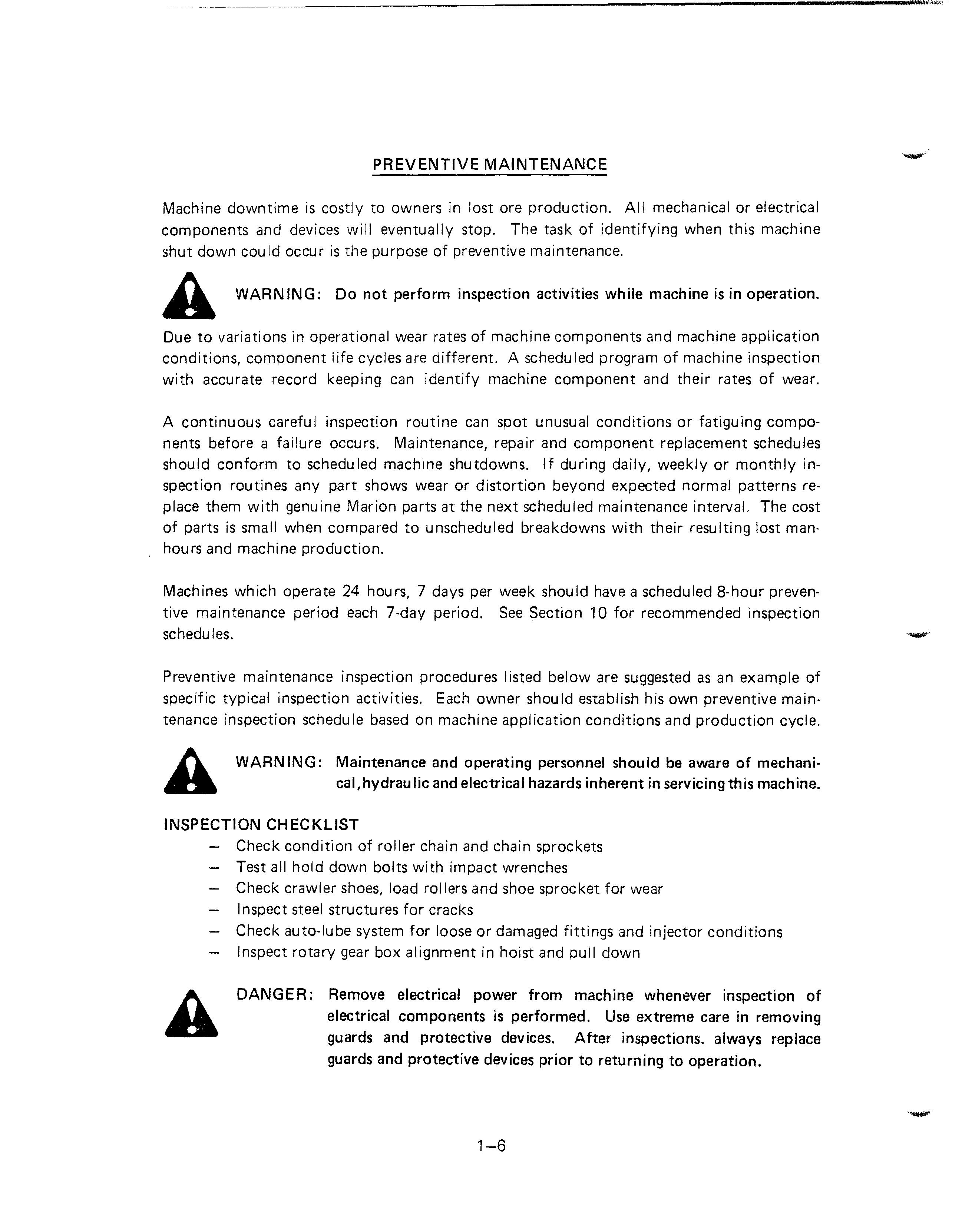
AWARNING: Maintenance and operating personnel should be aware of mechanical, hydrau lic and electrical hazards inherent in servicing th is machine.
INSPECTION CHECKLIST
Check condition of roller chain and chain sprockets
Test all hold down bolts with impact wrenches
Check crawler shoes, load rollers and shoe sprocket for wear
I nspect steel structu res for cracks
Check auto-lube system for loose or damaged fittings and injector conditions
Inspect rotary gear box alignment in hoist and pull down
ADANGER: Remove electrical power from machine whenever inspection of electrical components is performed. Use extreme care in removing guards and protective devices. After inspections. always replace guards and protective devices prior to returning to operation. 1-6
PREVENTIVE MAINTENANCE - continued
DANGER: REMOVE ELECTRICAL POWER FROM MACHINE BEFORE PERFORMING ANY OF THE FOLLOWING INSPECTIONS:
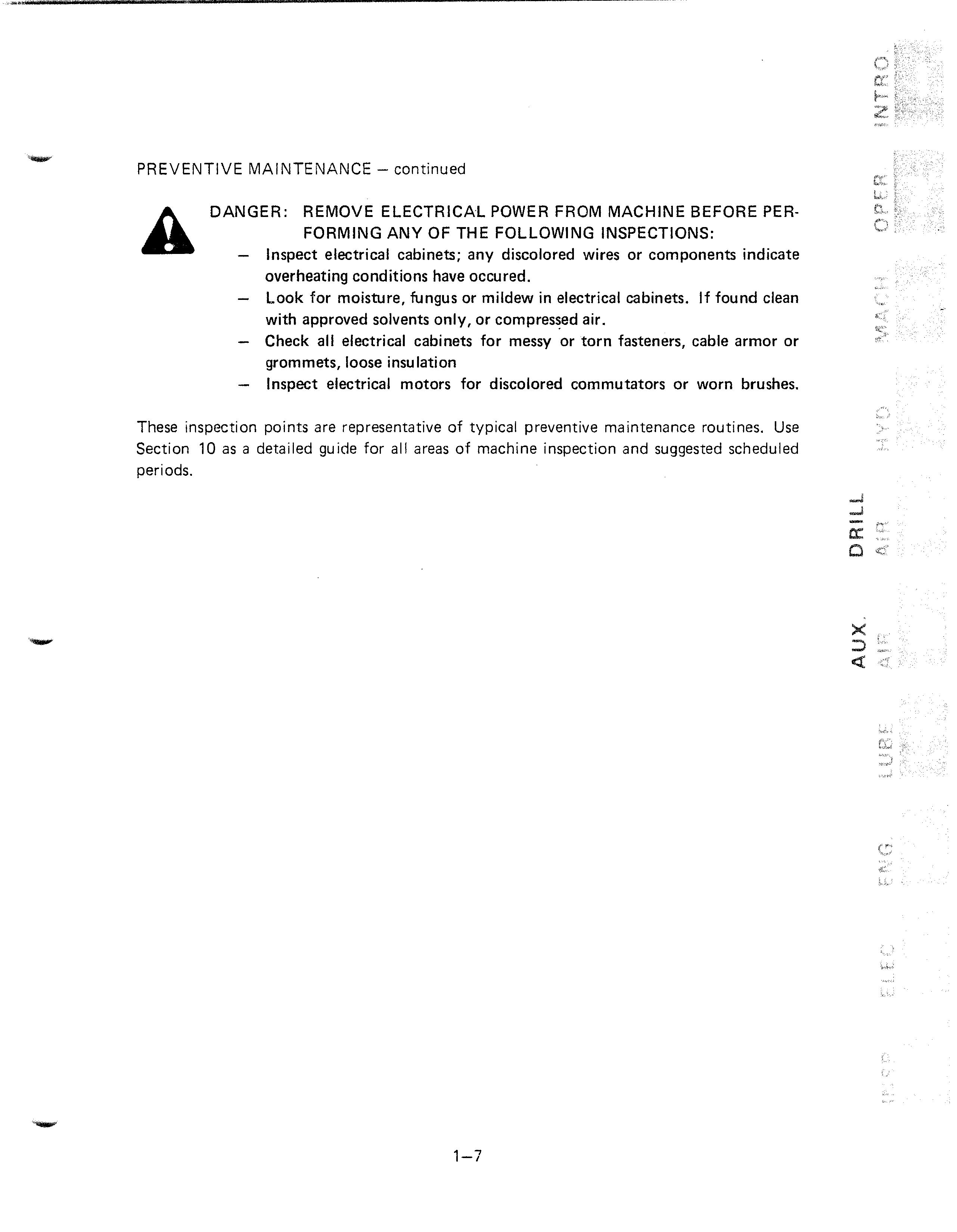
Inspect electrical cabinets; any discolored wires or components indicate overheating conditions have occured.
Look for moisture, fungus or mildew in electrical cabinets. If found clean with approved solvents only, or air.
Check all electrical cabinets for messy or torn fasteners, cable armor or grommets, loose insu lation
Inspect electrical motors for discolored commutators or worn brushes.
These inspection points are representative of typical preventive maintenance routines. Use Section 10 as a detailed guide for all areas of machine inspection and suggested scheduled periods.



